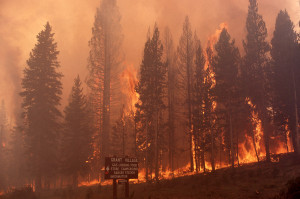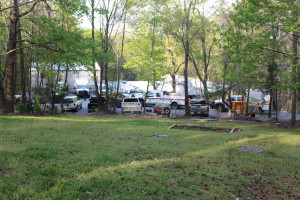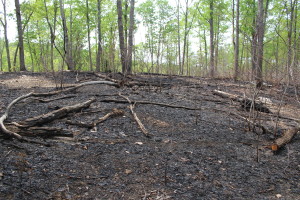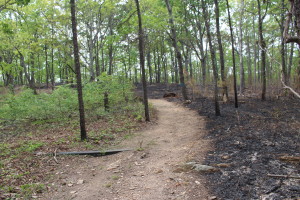One of the first things we learned at Kings Mountain NMP is that they would have a prescribed burn. This is something that happens almost every year as the National Park Service works to keep the underbrush down so that small fires don’t become huge forest fires that threaten property and lives. For years, the National Park Service had a policy of putting out all fires. But suppressing fire is not the natural way in the forest. Fire can be a friend to forests. Some kinds of trees need fire to release their seeds. Other trees struggle for survival if there are too many trees because of fire suppression.

In 1968, the National Park Service changed its policy to allow natural fires – fires caused by lightning – to burn as long as they didn’t threaten life or property. But the years of fire suppression caught up with the National Park service with a giant fire at Yellowstone in 1988 when almost 800,000 acres of the park burned. After that, the National Park Service reviewed its fire policies and decided to allow prescribed burns as well as some natural fires.
A prescribed burn is a fire set deliberately by the National Park Service when conditions are right. The conditions vary from park to park. All of the National Parks in South Carolina do prescribed burns on a somewhat regular basis. At Kings Mountain, they do them to return the forest to the condition it was in 1780 when the battle was fought here. At the time the trees in the forest were 3 to 4 feet in diameter and the canopy was high and thick so there was very little underbrush. Over time logging in the area cut down the giant trees and the woods became thick with smaller trees and lots of underbrush. Returning the forest to the “original” condition will take a very long time.
We knew that there were several scheduled burns for Kings Mountain during our time there. The fire interns worked for months clearing long fire suppression trails between sections of the park. The fire crews did a first fire at Cumberland Gap at the end of March. Then, just after a good rain, when the temperature, wind conditions, and humidity were within the established parameters, they did the prescribed burn at Kings Mountain along the Browns Mountain trail.

About 30 people gathered – fire crews from the other parks in the area – and began by getting all the equipment in place. Some people had drip torches that allowed them to drip fire onto the appropriate places. Some people were driving ATVs with water tanks on them to control fire getting out of the prescribed area. Some people had water backpacks that could be used in small areas or as a first response. Everyone had a Pulaski: a combination axe and mattock that can chop trees and clear ground.
They started the fire on the top of Browns Mountain, because you always want to start a fire at the highest elevation and send it down to keep it more controlled. At the appropriate time, people at the bottom of the mountain started the fire up, so it would meet the fire coming down the mountain and burn itself out.
Tom and I were a little concerned about the prescribed burn because our RV is very close to where the fire would be. We closed all the windows, hoping the RV wouldn’t smell like smoke at the end of the day, and went to work. We listened to the radio traffic at work, ready to run back and pull the RV out of harms way.

The burn went perfectly. The fires were set on schedule, burned just the way they were supposed to, and were out by the end of the day. The burn took place on a Thursday, and by Saturday all the hot spots were out and the trail to Browns Mountain was open to hikers. We made sure we warned the hikers about the burn so they wouldn’t be surprised.
A few days later Tom and I hiked the Browns Mountain trail to see what the area looked like after the burn. We were pleasantly surprised. Although you could tell that a burn took place (the ground was black and free of debris), the fire had not reached the limbs of most of the trees and the forest still looked very green. Most areas had burning up about six feet high, but it looked like the area would lose the signs of the burn after just a few months.

After the burn was finished at Kings Mountain, the fire crews were off to Congaree to repeat the process. Burns were also scheduled for Cowpens and another one for Kings Mountain, if conditions continued to be favorable. Pretty soon it will be too hot for a prescribed burn, and the crews will begin to look for wildfires, deciding how to treat each one on an individual basis.
